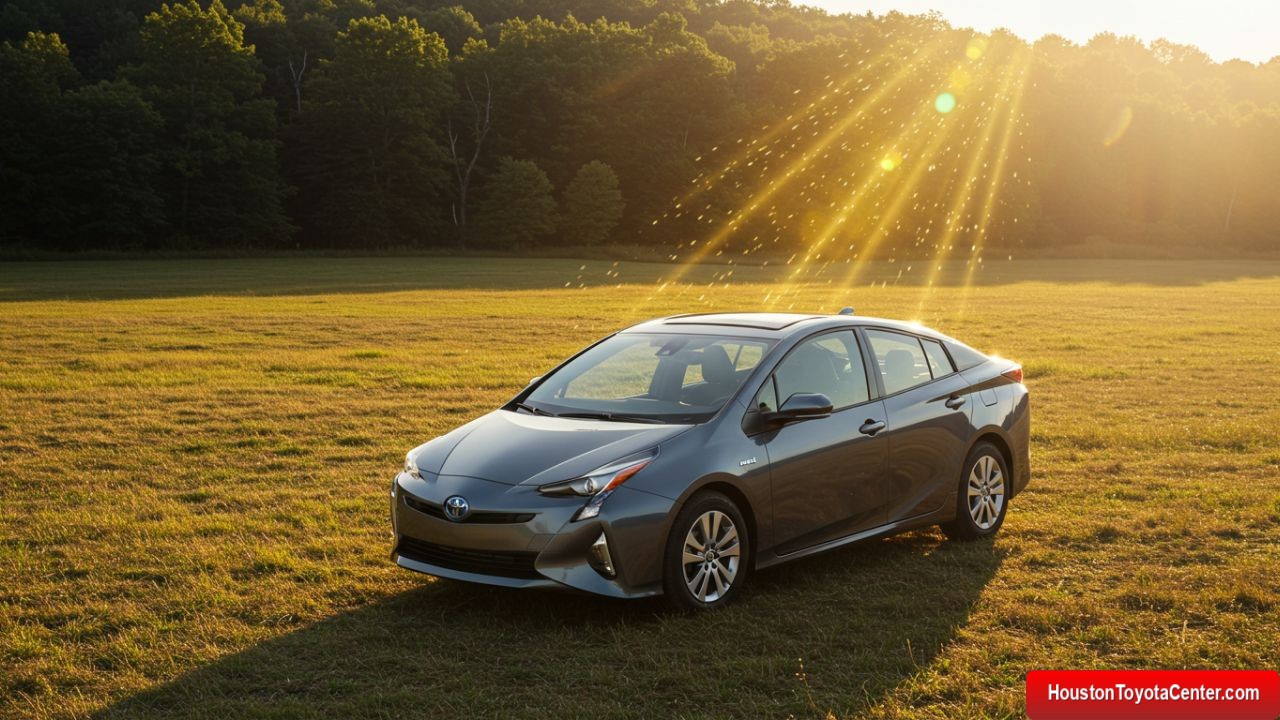As the world accelerates toward sustainable mobility, solar energy has emerged as a promising supplement to electric and hybrid vehicles. Toyota, a long-standing pioneer in eco-friendly automotive technology, has been exploring solar integration in several of its models — most notably in vehicles like the Toyota Prius Prime and Toyota bZ4X. But how much power can you actually get from Toyota’s solar charging system? Is it a gimmick, or a meaningful addition?
In this article, we dive deep into how Toyota’s solar charging system works, how much energy it produces, where it shines (pun intended), and how it fits into the broader transition to green transportation.
☀️ What Is the Toyota Solar Charging System?
Toyota’s solar charging system is a photovoltaic (PV) setup designed to collect sunlight and convert it into electric energy for vehicle use. The solar panels are typically integrated into the roof of the car, and in some cases, also the hood and rear deck. The collected energy can power auxiliary systems or be stored in the vehicle’s main battery for propulsion.
This technology has been developed in collaboration with Sharp Corporation and NEDO (New Energy and Industrial Technology Development Organization) in Japan, focusing on increasing solar efficiency in compact applications.
FREE: Quickly identify and understand problems with your vehicle 🚘
CLICK HERE🔧 How the System Works
The Toyota solar roof system works in two primary modes:
1. Charging While Parked
When the car is parked in direct sunlight, the solar panels collect energy and feed it into the battery. This helps top off the battery throughout the day, especially useful for drivers who park outdoors during work hours.
2. Charging While Driving (in some models)
In models like the Toyota Prius PHV (Plug-in Hybrid) in Japan, Toyota enabled on-the-go charging, where solar energy feeds power directly into the driving system and battery while the car is moving.
This dual-mode operation makes it one of the most advanced solar charging systems ever installed in a mass-market car.
⚡ How Much Power Does Toyota’s Solar Roof Generate?
The actual power generation varies depending on factors such as location, weather, panel size, and system efficiency. However, Toyota has released key data from both lab and field testing.
📊 Solar Power Generation Estimates
| Model | Solar Panel Power Output (Peak) | Daily Range (Ideal Conditions) | Annual Energy Production |
|---|---|---|---|
| Prius Prime (Japan-only) | 860W | 3.7 – 6.1 km/day (2.3 – 3.8 mi/day) | ~1,000 km/year (621 mi/year) |
| Prius Prime (US version) | ~200W (older versions) | 1.6 – 2.3 km/day (1 – 1.4 mi/day) | ~500 km/year (310 mi/year) |
| Concept bZ4X Solar Roof | 1,000W+ (Prototype) | Up to 11.6 km/day (7.2 mi/day) | ~1,700 km/year (1,056 mi/year) |
🔍 Note: These values are based on sunny climates like California or southern Japan. Cloudy weather, shadowing, and winter months reduce efficiency.
📐 Real-World Example: Prius PHV Solar Charging
Let’s look closer at the Japan-exclusive Prius PHV with the full solar roof system:
- Solar Panel Output: 860 watts
- Battery Size: 8.8 kWh (Prius Prime)
- Estimated Solar Contribution (per year): ~1,000 km or 621 miles
In Tokyo, with an average of 5.5 sun-hours per day, this system can generate approximately 3 to 4 miles of range daily. While this may seem modest, for urban commuters or short-trip drivers, this could mean a week’s worth of travel without plugging in.
🌍 What Determines Solar Charging Efficiency?
The actual performance of Toyota’s solar system depends on a mix of environmental and design factors:
☀️ Sunlight Exposure
- More sun = more power. Locations closer to the equator see better solar return.
- Roof orientation and parking behavior (outdoors vs. indoors) heavily influence output.
📏 Panel Size and Technology
- Larger and more efficient panels generate more wattage.
- Toyota’s panels use high-efficiency monocrystalline silicon for better yield in limited space.
🧠 Energy Management Software
- Sophisticated onboard energy management determines how to allocate solar input — whether for battery charge or powering auxiliaries.
💰 Is It Worth It? Solar Charging vs. Plug-in Charging
Let’s break it down:
🔌 Plug-in Charging (Level 2)
- Power: ~6.6 kW (6,600 watts)
- Full Charge Time (8.8 kWh): ~2 hours
- Cost: $0.12–$0.25 per kWh = ~$1.05–$2.20 per full charge
☀️ Solar Charging
- Power: 200–1,000 watts
- Full Charge Time: Days (depending on conditions)
- Cost: $0 (once installed)
| Comparison | Plug-in Charging | Solar Charging |
|---|---|---|
| Speed | Very Fast | Very Slow |
| Cost (per use) | Low, but not zero | Free |
| Carbon Footprint | Depends on energy grid | Zero emissions |
| Convenience | Requires charger access | Requires sun access |
⚖️ Verdict: Solar charging won’t replace wall charging, but it adds free, clean energy that accumulates over time — ideal for topping off and reducing your grid dependency.
🚘 Which Toyota Models Offer Solar Charging?
Currently, only select Toyota models feature the solar roof option:
✅ Available or Previously Available:
- Toyota Prius Prime (Japan): Advanced solar charging roof with driving-time support
- Toyota Prius Prime (U.S.): Solar roof for auxiliary functions only (e.g., fan ventilation)
- Toyota bZ4X (Prototype): Solar panel roof in development
- Toyota Crown Estate EV (Upcoming): Expected to include solar panel options
Toyota has been clear that the solar roof is an evolving technology, and it’s likely to expand across the lineup as panel efficiency and consumer demand increase.
🔋 Can Solar Panels Fully Charge a Car?
Let’s do the math.
Hypothetical Full Solar Charge:
- Battery Size (e.g., bZ4X): ~71.4 kWh
- Solar Roof Output: ~1,000W
- Sunlight Hours (Ideal): 6/day
- Daily Energy Produced: 1,000W × 6h = 6 kWh/day
- Days to Full Charge: 71.4 ÷ 6 = ~12 days
So yes, technically a full solar roof could charge a car, but it would take several days under perfect conditions. That’s why it’s best seen as a supplement — not a primary energy source.
🌞 Advantages of Toyota’s Solar Charging System
✅ Sustainable Energy
- Reduces dependence on fossil fuels and power grids
- Zero emissions during power generation
✅ Passive Charging
- Charges the battery silently and automatically without driver intervention
✅ Great for Daily Top-Offs
- Ideal for short commutes, errands, and reducing charging frequency
✅ Longer Battery Life
- Frequent shallow charging from solar can be gentler on battery health
🚫 Limitations to Consider
Despite the benefits, solar charging has real limitations:
- Low Power Density: You can only generate so much power from limited rooftop real estate
- Weather Dependent: Cloudy days reduce yield significantly
- Added Cost: The solar roof often adds ~$2,000–$3,000 to the vehicle price
- Limited Availability: Only a few models offer it as of 2025
🔮 Future Outlook: Where Is Toyota Going with This?
Toyota is taking solar seriously. With growing interest in solid-state batteries, vehicle-to-grid (V2G) systems, and net-zero manufacturing, Toyota envisions solar roofs as part of a holistic energy ecosystem.
Additionally, solar panels might not remain limited to roofs. Toyota and other automakers are experimenting with solar glass, trunk lids, hoods, and portable solar mats that extend the area for energy harvesting.
We may also see solar-powered micro-mobility vehicles — such as Toyota’s concept urban pods or last-mile delivery EVs — where lightweight + small batteries = solar becomes more viable.
🏁 Conclusion: How Much Power Does It Really Generate?
- Toyota’s solar charging system can generate up to 1,700 km (1,056 miles) of range per year under ideal conditions.
- This translates to 3–7 miles of daily driving without plugging in — completely solar-powered.
- While it won’t eliminate the need for traditional charging, it does make a meaningful contribution to fuel savings and carbon reduction over time.
For eco-conscious drivers or tech enthusiasts, Toyota’s solar roof is a futuristic add-on that blends sustainability with practicality. As solar efficiency improves and prices come down, we may see this feature become more common — and more powerful — in future vehicles.
Toyota’s solar charging system offers up to 1,000W of clean energy, enough to add 3–7 miles of daily range. It can’t replace charging stations yet, but it complements plug-in charging while reducing emissions, electricity bills, and environmental impact.
✅ Final Word
Is the solar roof for everyone? Maybe not today. But as the technology evolves, Toyota’s solar innovations are lighting the path toward a cleaner, smarter, and more energy-independent driving experience.


Leave a Reply